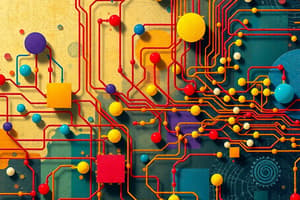Podcast
Questions and Answers
Which function of an operating system is responsible for managing how processes are created and terminated?
Which function of an operating system is responsible for managing how processes are created and terminated?
- Memory management
- Process management (correct)
- Device management
- File system management
In a distributed system, what feature allows components to continue functioning even if some fail?
In a distributed system, what feature allows components to continue functioning even if some fail?
- Scalability
- No shared clock
- Fault tolerance (correct)
- Asynchronous communication
What distinguishes Harvard architecture from Von Neumann architecture?
What distinguishes Harvard architecture from Von Neumann architecture?
- Separates storage for data and instructions (correct)
- Allows for greater scalability
- Uses single storage for instructions
- Interconnects components via buses
Which of the following is NOT a characteristic of distributed systems?
Which of the following is NOT a characteristic of distributed systems?
Which principle in system design involves organizing a system into manageable parts?
Which principle in system design involves organizing a system into manageable parts?
What is primarily managed by the device management function of an operating system?
What is primarily managed by the device management function of an operating system?
Which of the following best describes the term 'data flow' in system architecture?
Which of the following best describes the term 'data flow' in system architecture?
Which option represents an example of a distributed system?
Which option represents an example of a distributed system?
What is the main goal of maintainability in a system?
What is the main goal of maintainability in a system?
Which component in a network system refers to the individual devices?
Which component in a network system refers to the individual devices?
Which type of network typically has a high speed and operates over a limited geographic area?
Which type of network typically has a high speed and operates over a limited geographic area?
What is a characteristic of Peer-to-Peer networks?
What is a characteristic of Peer-to-Peer networks?
During the architectural design stage, what is focused on?
During the architectural design stage, what is focused on?
What role do protocols play in network systems?
What role do protocols play in network systems?
Flashcards are hidden until you start studying
Study Notes
Operating Systems
- Definition: Software that manages hardware and software resources on a computer.
- Functions:
- Process management: Handles the creation, scheduling, and termination of processes.
- Memory management: Allocates and deallocates memory space as needed.
- File system management: Provides a way to store and retrieve files on storage devices.
- Device management: Manages device communication via drivers.
- User interface: Facilitates interaction between the user and the system (CLI or GUI).
Distributed Systems
- Definition: A model where components located on networked computers communicate and coordinate their actions.
- Characteristics:
- No shared clock: Each component operates independently.
- Asynchronous communication: Components communicate through messages over a network.
- Scalability: Can grow by adding more nodes.
- Fault tolerance: Can continue operation even if some components fail.
- Examples: Cloud computing, peer-to-peer networks, and microservices architecture.
System Architecture
- Definition: The conceptual model that defines the structure, behavior, and more views of a system.
- Key Aspects:
- Components: Individual parts of the system (e.g., processors, memory, I/O devices).
- Interconnections: How components communicate (e.g., buses, networks).
- Data flow: Path of data within the system.
- Layering: Organizes system into layers for abstraction and separation of concerns.
- Types:
- Von Neumann architecture: Single memory for data and instructions.
- Harvard architecture: Separate storage for data and instructions.
System Design
- Definition: Process of defining the architecture, components, modules, interfaces, and data for a system.
- Key Principles:
- Modularity: Dividing a system into smaller, manageable parts.
- Abstraction: Simplifying complex systems by hiding details.
- Scalability: Designing systems to handle growth.
- Maintainability: Ensuring the system can be updated and repaired easily.
- Stages:
- Requirements analysis: Understanding user needs.
- System specification: Defining what the system should do.
- Architectural design: High-level structure of the system.
- Detailed design: Specifics of components and interactions.
Network Systems
- Definition: Systems that involve multiple computers and devices communicating over a network.
- Components:
- Nodes: Individual devices (computers, servers, routers).
- Links: Connections between nodes (wired or wireless).
- Protocols: Rules governing communication (e.g., TCP/IP, HTTP).
- Types of Networks:
- Local Area Network (LAN): Limited geographic area, high speed.
- Wide Area Network (WAN): Covers large geographic areas, lower speed.
- Peer-to-Peer: Direct connection between nodes without a central server.
- Functions:
- Data transmission: Transfer of data between devices.
- Resource sharing: Allows multiple users to access shared resources.
- Communication: Facilitates interaction through various services (emails, messaging).
Operating Systems
- Manages hardware and software resources on a computer.
- Functions include:
- Process management: Oversees the lifecycle of processes, including creation, scheduling, and termination.
- Memory management: Responsible for memory allocation and deallocation.
- File system management: Facilitates the storage and retrieval of files on storage devices.
- Device management: Coordinates device communication through drivers.
- User interface: Provides interaction methods, either Command Line Interface (CLI) or Graphical User Interface (GUI).
Distributed Systems
- A model where components on networked computers communicate and coordinate actions.
- Characteristics:
- No shared clock: Each component operates independently without synchronized timing.
- Asynchronous communication: Components communicate via messages sent over a network.
- Scalability: Capable of expanding by adding more nodes.
- Fault tolerance: Remains operational despite the failure of some components.
- Examples: Cloud computing, peer-to-peer networks, microservices architecture.
System Architecture
- Conceptual model defining the structure and behavior of a system.
- Key Aspects:
- Components: Parts of the system such as processors, memory, and I/O devices.
- Interconnections: Communication methods among components (e.g., buses, networks).
- Data flow: The path and management of data transitioning within the system.
- Layering: Organizes the system into layers for improved abstraction and separation of concerns.
- Types:
- Von Neumann architecture: Utilizes a single memory space for both data and instructions.
- Harvard architecture: Employs separate storage for data and program instructions.
System Design
- Process that defines the architecture, components, modules, interfaces, and data for a system.
- Key Principles:
- Modularity: Breaks down a system into manageable, smaller parts.
- Abstraction: Simplifies complex systems by concealing intricate details.
- Scalability: Design must accommodate growth and increased demand.
- Maintainability: Ensures ease of updating and repair.
- Stages include:
- Requirements analysis: Gathers and defines user needs.
- System specification: Outlines the functionalities the system must provide.
- Architectural design: Defines high-level structure and components.
- Detailed design: Focuses on specific components and their interactions.
Network Systems
- Systems involving multiple computers and devices that communicate over a network.
- Components:
- Nodes: Individual devices such as computers, servers, and routers.
- Links: Connections between nodes that can be wired or wireless.
- Protocols: Sets of rules regulating communication (e.g., TCP/IP, HTTP).
- Types of Networks:
- Local Area Network (LAN): Operates within a limited geographic area, typically high-speed.
- Wide Area Network (WAN): Spans large geographic areas with generally lower speeds.
- Peer-to-Peer: Direct connections between nodes without a centralized server.
- Functions:
- Data transmission: Enables data transfer between devices.
- Resource sharing: Allows multiple users to access shared resources efficiently.
- Communication: Facilitates interactions through services such as email and messaging.
Studying That Suits You
Use AI to generate personalized quizzes and flashcards to suit your learning preferences.





